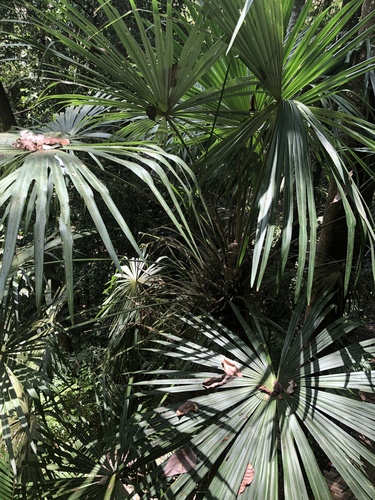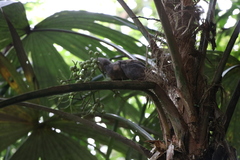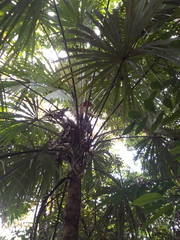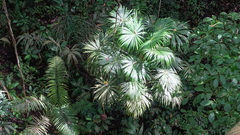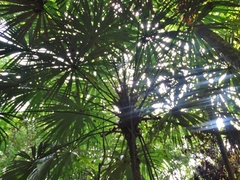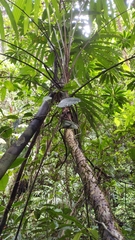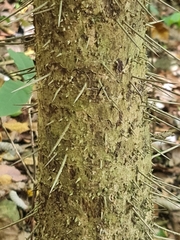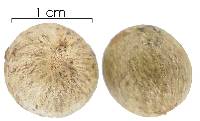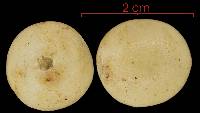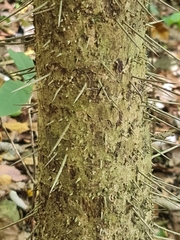

|
|
|
|
Family: Arecaceae
Guágara, more...nolí
|
Description: A small to medium-sized palm, reaching about 10 m in height, with a trunk densely covered with sharp spines. The spines are gray, and can be forked, that is, with spines branching off the spines. This is a fan palm, with leaflets radiating away from a central point. Leaves are whitish on the underside. Distribution: Found only on the Pacific half of the isthmus, but very patchy. There is a dense concentration in the forest behind Gamboa and across the river from Gamboa, another one at Plantation Rd., and another in a plot of ours west of the Canal near the Pacific. Other than these concentrations, the species is sparse. It is present on BCI according to Croat's flora, but not in any of our plots there. Similar Species: This is the only native fan palm in central Panama, so the only fan palm encountered in the forest. The other fan palms are restricted to roadsides of the Canal area, and Cryosophila is not seen in towns or along roads. Other forest palms have spines on the trunk, such as LK bactma Bactris spp. LK2 and LK ast1st Astrocaryum standleyanum, LK2 but their leaves are pinnate and their spines are black and unbranched. Juveniles of Cryosophila -- before they have a trunk -- are often mistaken for the Panama hat plant, Carludovica palmata, which has the same kind of fan-shaped leaf. Learn Carludovica's leaf from the many individuals growing in towns, gardens, and along roads in the Canal area, and you will find it is really not that similar to the leaf of Cryosophila. Descripción: Palma que alcanza de 3 a 10 m de alto. Tronco solitario y cubierto de espinas ramificadas de color blanco. Hojas palmadas y en forma de abanico, de 2-3 m de largo, con 30 o más folíolos, verdes en el haz y blancos o grises por el envés. Pecíolo de 100-200 cm de largo y acanalados en la parte superior. Flores bisexuales y de color blanco. Frutos globosos, de 1.3-2.3 cm de diámetro, verdes, tornándose blancos al madurar. Datos Ecológicos: La especie crece a bajas y medianas elevaciones, en bosques húmedos o muy húmedos. En Panamá se encuentra en las provincias de Bocas del Toro, Chiriquí, Coclé, Colón, Panamá y la comarca de Guna Yala. Común en bosques deciduos con suelos rocosos de los alrededores del lago Alajuela. Florece y fructifica de mayo a diciembre. Especies Parecidas: Se puede confundir con LK sabama Sabal mauritiiformis LK2 , pero S. mauritiiformis no tiene espinas en el tronco. También se puede confundir con Carludovica palmata (Cyclanthaceae), pero C. palmata no tiene tronco. Usos: Las hojas son empleadas para fabricar escobas y techos de ranchos. Los brotes de las hojas jóvenes tienen un compuesto venenoso utilizado como barbasco en la captura de peces. Tree, to 10 m tall; trunks 10-15 cm diam above the enlarged base, much of the trunk bearing spines, at least when young, the spines simple or branched, to 16 (35) cm long, sometimes restricted to base of older plants. Petioles longer than blade, broadly canaliculate; blades round in outline, 1.5-2 m diam or more, palmately veined and irregularly lobed almost to base, lobed completely to base on lower margin, green and glabrous on upper surface, densely whitish-pubescent on lower surface, the trichomes so small and appressed as to appear glaucous (sometimes arachnoid with brown trichomes on veins); juvenile blades triangular in outline, deeply 2- or 3-lobed (more in age), densely arachnoid-pubescent. Inflorescences interfoliar, nodding, the spathelets (nodifronds) short, acuminate, densely woolly on outside, ultimately deciduous, the outer ones coriaceous, the outermost usually bearing 2 keels, the inner ones longer, each subtending a branch of the spadix, to 15 or 30 cm long, closely enveloping at least lower part of branch; spadix branches at least as long as broad, 30-75 cm long, the main axis stout, the branches very short or to ca 30 cm long, densely flowered; flowers bisexual, 3-parted, glabrous; sepals oblong; petals broadly obovate to rounded, concave, 2.5-4 mm long, the margins thin, the sepals and petals stiff, erect, forming a narrow tube; stamens 6; filaments in pairs, flattened, broad and united at base, slightly longer than petals and cernuous near apex; anthers ca 1 mm long, pendent on outside of corolla just above apex; pistils 3, narrowly ovoid, long-tapered to apex, curved outward just above apex; stigmas held just above.throat of corolla. Fruits round to obovate, mostly 1-2 cm diam, smooth, fleshy and white at maturity; pericarp thin; seed 1, round, 8 mm or more diam. Croat 17017. Recognized by the palmate leaves, the white fleshy fruits, and the branched spines on the trunk, which Bailey (1943) considered to be root thorns. Cryosophila albida Bartl. and C. guagara P. H. Allen cannot be considered distinct from C. warscewiczii, since key characters such as pubescence and fruit size are very variable. Belize to Panama, no doubt also Colombia. In Panama, known from tropical moist forest on both slopes of the Canal Zone and in Panama and Darien; known also from premontane wet forest in Coclé (El Valle) and Panama (Cerro Campana) and from tropical wet forest in Darien. See Fig. 63. |

